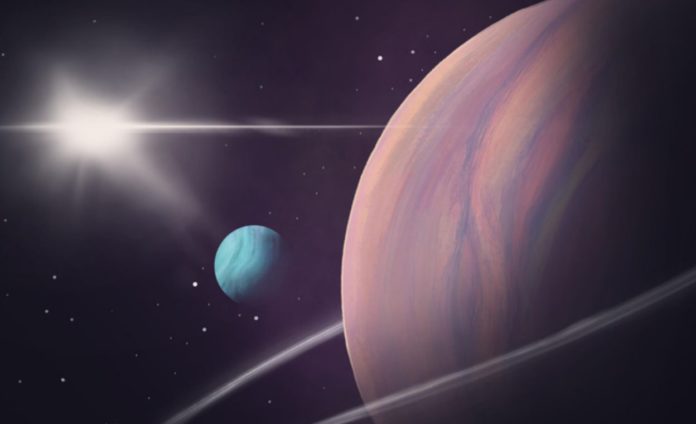Astronomers have found a new candidate for an exomoon — a moon that orbits planets beyond the realm of our Solar System.
An exomoon signal discovered in old data suggests that there may be more discoveries to come.
Astronomers have discovered a second super-sized moon orbiting a Jupiter-sized planet beyond our solar system.
If confirmed, the discovery could indicate that exomoons are as prevalent as exoplanets in the universe and that such moons, large or small, are a feature of planetary systems. However, it may be a long wait.
The first-ever observation of an exomoon four years ago is still awaiting confirmation, and confirmation of this latest contender might take just as long and be just as contentious.
The discovery, which was published in Nature Astronomy, was led by David Kipping and his Cool Worlds Lab at Columbia University, which announced the first exomoon candidate in 2017.
“Astronomers have found more than 10,000 exoplanet candidates so far, but exomoons are far more challenging,” says Kipping, who has spent the last decade hunting for exomoons. “They are terra incognita.”
The researchers discovered the enormous exomoon candidate orbiting the planet Kepler 1708b, which is about 5,500 light-years away from Earth in the constellations Cygna and Lyra. This new candidate is roughly one-third the size of the Neptune-sized moon discovered by Kipping and colleagues earlier this year orbiting a similar Jupiter-sized planet, Kepler 1625b.
According to Kipping, both supermoon candidates are likely formed of gas that has accumulated because of their massive size’s gravitational pull. If one astronomer’s theory is right, the moons may have begun life as planets before being drawn into the orbit of a larger planet, such as Kepler 1625b or 1708b.
Both moons are far from their host star, where gravity is weaker and planets are stripped of their moons. In fact, the researchers looked for cold, massive gas planets with broad orbits in their search for exomoons because our own solar system’s equivalent, Jupiter and Saturn, have over a hundred moons between them.
If there are additional moons out there, they will be less monstrous but also harder to find, according to Kipping.
“The first detections in any survey will generally be the weirdos,” he said. “The big ones that are simply easiest to detect with our limited sensitivity.”
Astronomers are fascinated by exomoons for the same reasons they are fascinated by exoplanets. They may show how and where life may have originated in the universe. Exomoons are fascinating in and of themselves, and astronomers want to know how they arise, if they can support life, and what role, if any, they play in making their host planets habitable.
The researchers examined data from NASA’s Kepler planet-hunting mission, which caught a sample of the coldest gas giant planets. They uncovered only one candidate — Kepler 1708b — with a moon-like signal after studying 70 planets in detail.
“It’s a stubborn signal,” said Kipping. “We threw the kitchen sink at this thing but it just won’t go away.”
To confirm the discovery, observations from other space observatories, including Hubble, would be required, a procedure that might take years. Kipping’s first exomoon discovery is still fiercely discussed four years later. He and his colleagues recently published a study demonstrating how one set of skeptics may have overlooked Kepler 1625b’s moon in their calculations. Meanwhile, Kipping and his colleagues continue to look into other possibilities.
According to Eric Agol, an astronomy professor at the University of Washington, this recent signal is unlikely to be real.
“It might just be a fluctuation in the data, either due to the star or instrumental noise,” he said.
Others sounded more optimistic. “This is science at its best,” said Michael Hippke, an independent astronomer in Germany. “We find an intriguing object, make a prediction, and either confirm the exomoon candidate or rule it out with future observations.”
“I am very excited to see a second exomoon candidate, although it is unfortunate that only two transits have been observed,” he added. “More data would be very cool.”
It’s not easy to find a moon or even a planet hundreds to thousands of light-years away from Earth. Moons and planets can only be seen indirectly because they pass in front of their host stars, which causes the star’s light to fade. Using a telescope to catch one of these transient transit signals is difficult, as is deciphering the light-curve data. Because moons are smaller and obstruct less light, they are considerably more difficult to detect.
But the quest is worthwhile, according to Kipping, who recalls how the discovery of exoplanets was met with the same suspicion as the discovery of exomoons today.
“Those planets are alien compared to our home system,” he said. “But they have revolutionized our understanding of how planetary systems form.”
Source: Study
Image credit: HELENA VALENZUELA WIDERSTRÖM
You were reading: Exomoons hunter finds second, super-sized moon orbiting Jupiter-like planet
